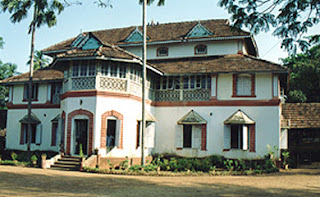
Hill Palace Thripunithura, Ernakulam District, Kochi
History
Hill Palace is located in Thripunithura/Tripunithura, in
Ernakulam district of the state of Kerala. Constructed in 1865, the
museum (previously a palace) used to be the official residence of the
Kochi Royal family. The palace has now been converted into the present
day museum. The museum holds the collection of the paintings of the
erstwhile Maharaja of Kochi. The palace complex is a large enclosed area
which comprises of 49 buildings, which were built in traditional Kerala
style architecture. The palace compound is spread over 52 acres of
area. This compound includes beautiful fountains which are a piece of
art. Apart of these fountains the compound also guards elaborately lush
lawns and a number of ponds. There are a number of rare medicinal plants too, which have been
cultivated here. The Ethno-archaeological museum displays a number of
ancient murals, oil-paintings, Stone artifacts and coins, along with
manuscripts and sculptures, which belongs to the Kochi Royal Family. The
first building constructed inside the complex is a single storied
Ettukettu, which is supposed to be constructed in the year 1850. There
is a traditional pond and a temple alongside this building. This
building is constructed in traditional Kerala architecture style,
according to which a residential building should be added with a pond
and a temple. The latest addition to the palace compound is the
three-storey museum office, which was constructed in the year 1950 in
western style. The palace was announced as a historical site and was taken over by the
Department Of Archaeology in the year 1980. Six years later in 1986, the
palace was opened to public. However, the museum was closed to public
during the time, because rigorous renovation works were taking place.
The palace was almost rebuilt and major changes were done to the
exteriors of the compound. The palace was fitted with intricate
carvings, which add to the ambiance of the palace. The palace is
elaborately designed, while the museum is divided into 14 different
categories of exhibits, including inscriptions, paintings, murals,
manuscripts, sculpture in stone and plaster of Paris, carvings etc. This
palace is one of the major examples of Nalukettu form of architecture,
which was appreciated in Kerala at the medieval times and is still
valued.







